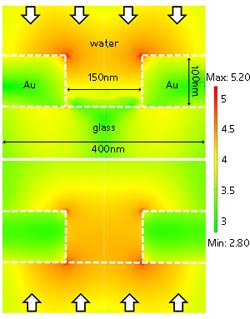Photonics: Sensing with holes

SPP sensing. Nanohole films can be used in two different configurations to sense molecules in a water solution. In the reflection mode (top), light is directed at the sample from the water side. In the transmission mode (bottom), light is directed at the sample from the back, leading to different SPP properties. The SPP field intensity is represented by the color plot. The optical fields on the top and bottom are calculated for different resonance frequencies. © 2012 IEEE<br>
The detection of small quantities of molecules is important for a myriad of applications, ranging from gas sensing to biomedical diagnostics. The majority of these applications require the sensors to be cheap and disposable, yet sensitive enough to detect molecules down to the single-molecule level.
Ping Bai and co-workers at the A*STAR Institute of High Performance Computing and the Institute of Materials Research and Engineering have now studied the properties of thin metallic films with holes in them that are particularly promising for molecular sensing.
Metallic thin films with nanometer-sized holes in them are known to transmit light of particular wavelengths very efficiently. The efficiency arises from surface plasmon polaritons (SPPs) — the collective movements of electrons on the metal surface — which are able to focus light into tiny spots much smaller than the wavelength of light used (see image).
These SPPs can be used to detect the molecules through the fluorescence of tracer molecules attached to them. This fluorescence is also strongly enhanced by the SPP and can easily be detected by a microscope even for small quantities of molecules. “The whole setup is ultra-compact to support a point-of-care sensing system,” explains Bai.
Bai and his colleagues studied two sensing arrangements. In the first arrangement, light is directed at a film with nanoholes at an oblique angle from the same side as the sample. In the second arrangement, the film is illuminated from the back so that light is travelling through the holes first. The researchers found that each scheme has its own advantages.
In the ‘reflection’ scheme, the SPP effect is stronger as the light is directly aimed at the sample and does not have to cross the metal film. However, a thicker film is needed so that the light does not pass through. In the ‘transmission’ scheme, the intensity of the light emitted by the molecules is weaker, but the advantage there is that filters and other sensors can possibly be included with the metal film, and the film thickness can be much thinner.
“There is therefore no clear advantage for either sensing modes of such films,” says Bai. “One thing that is clear from the study, however, is the clear benefits of using metal films with nanoholes as a molecular sensing platform,” says Bai.
“This is merely a snapshot of our whole project. Ultimately, our sensing technology will be utilized in hospitals and test centers, for example, in prostate cancer screening, or even used at home just like glucose test kits,” adds Bai.
The A*STAR-affiliated researchers contributing to this research are from the Institute of High Performance Computing and the Institute of Materials Research and Engineering
References:
Wu, L., Bai, P., Zhou, X. & Li, E. P. Reflection and transmission modes in nanohole-array-based plasmonic sensors. IEEE Photonics Journal 4, 26–33 (2012).
Media Contact
All latest news from the category: Materials Sciences
Materials management deals with the research, development, manufacturing and processing of raw and industrial materials. Key aspects here are biological and medical issues, which play an increasingly important role in this field.
innovations-report offers in-depth articles related to the development and application of materials and the structure and properties of new materials.
Newest articles

Bringing bio-inspired robots to life
Nebraska researcher Eric Markvicka gets NSF CAREER Award to pursue manufacture of novel materials for soft robotics and stretchable electronics. Engineers are increasingly eager to develop robots that mimic the…

Bella moths use poison to attract mates
Scientists are closer to finding out how. Pyrrolizidine alkaloids are as bitter and toxic as they are hard to pronounce. They’re produced by several different types of plants and are…

AI tool creates ‘synthetic’ images of cells
…for enhanced microscopy analysis. Observing individual cells through microscopes can reveal a range of important cell biological phenomena that frequently play a role in human diseases, but the process of…





















